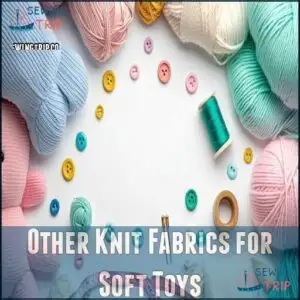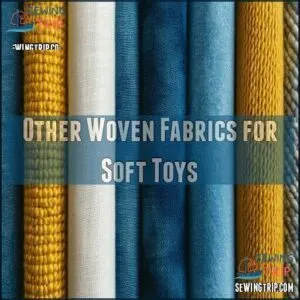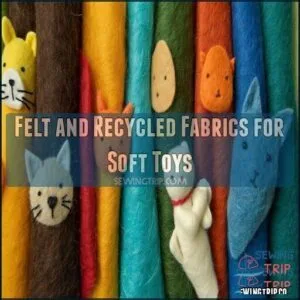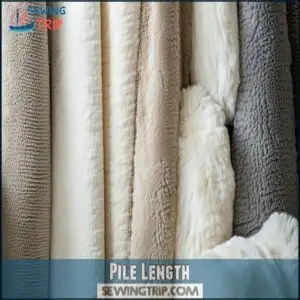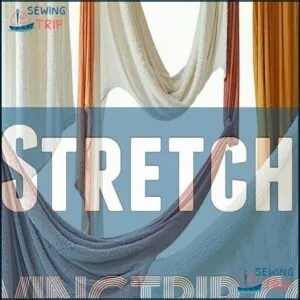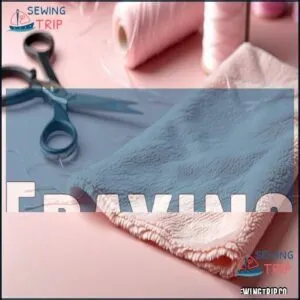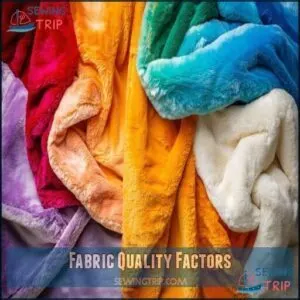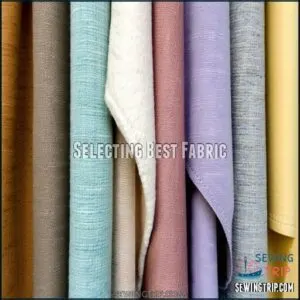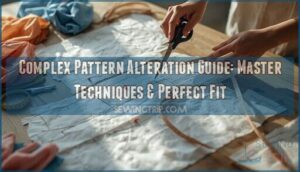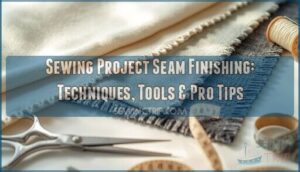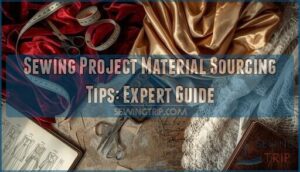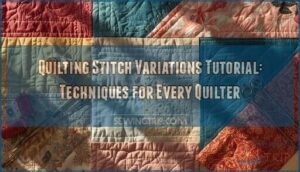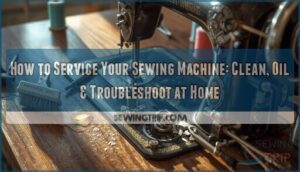This site is supported by our readers. We may earn a commission, at no cost to you, if you purchase through links.
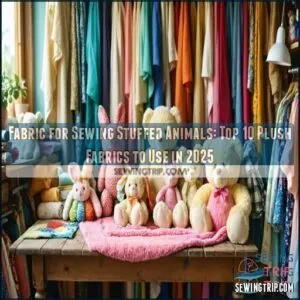
Soft, stretchy fleece is perfect for cuddly toys, while durable quilting cotton shines for detailed designs.
Minky fabric is a crowd favorite—it’s like wrapping your creation in a hug!
Felt is great for beginners since it doesn’t fray, and recycled fabrics add charm and eco-friendly vibes.
Consider softness, stretch, and even how it handles washing (because spills happen).
Each fabric brings its own personality to your project, so think about who—or what—you’re creating.
And trust me, the right fabric can bring your stuffed animal to life!
Table Of Contents
- Key Takeaways
- Fabric Types Overview
- Choosing Plush Fabrics
- Top 10 Plush Fabrics
- 1. Beige Minky Fabric for Sewing Projects
- 2. Knitted Polar Fleece Fabric Squares
- 3. Sew Adorable Pet Pillows to Make
- 4. Animal Theme Cotton Fabric Quarters
- 5. White Minky Fabric Soft Plush
- 6. Assorted Color Soft Felt Fabric
- 7. White Teddy Bear Plush Fabric
- 8. Woodland Animal Print Cotton Fabric
- 9. Kids Sewing Kit Beginner Crafts
- 10. Safari Animals Cotton Fabric Bundle
- Fabric Quality Factors
- Selecting Best Fabric
- Frequently Asked Questions (FAQs)
- Conclusion
Key Takeaways
- Focus on softness, durability, and washability when choosing fabric for plushies to ensure they’re cuddly and long-lasting.
- Minky, fleece, and felt are top picks for stuffed animals, offering a mix of coziness, ease of sewing, and affordability.
- Pre-cut options and hypoallergenic materials make crafting easier and safer, especially for kids and those with sensitive skin.
- Always test for fabric stretch, fraying, and shrinkage to avoid surprises when sewing and stuffing your creations.
Fabric Types Overview
When you’re sewing stuffed animals, picking the right fabric can make all the difference in softness, durability, and charm.
From fleece to recycled felt, each material brings its own unique perks and quirks to the crafting table.
Fleece Fabric for Soft Toys
Fleece fabric is a soft fabric that’s perfect for stuffed animals.
Its durability and cozy texture make it a top choice, especially for beginners. Plus, it’s budget-friendly!
Keep these perks in mind:
- It doesn’t fray.
- Easy washing, but watch for pilling.
- Stretch adds charm.
- A great minky fabric alternative.
Fleece cost suits every budget! You can easily find pre-cut fleece options for smaller projects.
Other Knit Fabrics for Soft Toys
Not all soft fabrics are created equal.
Knit fabrics like Interlock Knit, Rib Knit, and French Terry bring stretchiness and comfort to your projects.
These soft fabrics are perfect for hugging but require careful handling since they can fray or lose shape.
One can purchase interlock knit readily online.
Here’s a quick guide:
| Knit Type | Stretch Level | Durability | Best For |
|---|---|---|---|
| Knit Jersey | High | Moderate | Soft plush toys, lightweight designs |
| Rib Knit | Moderate to High | High | Cuddly plushies with subtle texture |
| Double Knit | Minimal | High | Toys needing durability and structure |
| French Terry | Low | Moderate | Cozy plush animals with soft texture |
Quilting Cottons for Soft Toys
Quilting cottons are perfect for sewing projects that prioritize fun prints and durability.
Their tight weave density and high thread count matter for a polished look, though they lack the stretch of soft fabrics like fleece.
Always pre-wash to prevent shrinking, and don’t skip colorfastness testing.
Great for stuffed animals’ accents, they’re a creative crafter’s dream! Many use them to make charming plush creations.
Other Woven Fabrics for Soft Toys
Looking for cotton alternatives in woven fabrics? Try these durable and versatile options:
- Linen: Lightweight and breathable, perfect for timeless designs.
- Canvas: Sturdy and tough, great for creating functional toy details.
- Denim: Offers resilience and a cool, vintage vibe.
- Corduroy: Soft yet textured, ideal for adding unique flair.
These fabrics combine practicality with charm!
Woven fabrics offer limited stretch properties compared to knits.
Felt and Recycled Fabrics for Soft Toys
If you loved experimenting with woven fabrics, then felt and recycled fabrics might just steal your heart.
Felt’s durability and textures make it perfect for detailed plushies, whether you choose wool felt or budget-friendly acrylic felt.
Felt’s durability and charm make it a go-to for crafting detailed plushies that stand out with timeless textures.
Plus, recycled sourcing helps create eco-friendly stuffing and upcycled plushies.
It’s a win-win—great for crafting and kinder to the planet!
Choosing Plush Fabrics
When you’re picking plush fabrics for stuffed animals, it all comes down to softness, stretch, and durability. Don’t worry—it’s easier than choosing between pizza toppings!
Softness
In the context of crafting soft toys and plushies, fabric softness isn’t just a luxury—it’s a must!
Think of the gentle Plush Texture of minky fabric or other Baby-Safe Fabrics ideal for little hands and sensitive skin.
Prioritize hypoallergenic options to guarantee a safe Sensory Experience.
Some prefer cashmere for softness, though it can be more expensive.
Plush fabric transforms stuffed animals into cuddly, comforting companions!
Pile Length
Pile length shapes the sensory experience and overall plush appearance of your stuffed animals.
When choosing plush fabric, consider these:
- Short piles add smoothness and durability.
- Medium piles balance coziness and cutting direction ease.
- Long piles, like faux fur, offer drama but need care.
High pile density improves softness, and products like minky fabric excel at capturing cuddly perfection, which is a key factor in the overall plush appearance.
Thickness
Fabric thickness affects your plushie’s feel and durability.
A thicker fabric, like minky fabric, adds density and reduces stuffing volume, while thinner options work better for layering effects.
Balance fabric weight with seam allowance to avoid bulky seams.
Remember, plush fabric thickness plays a key role in fabric quality.
Choose wisely for snuggly creations that hold their shape and charm!
Stretch
Stretch affects how your fabric behaves when stuffed.
Knit fabrics like minky stretch in all directions, while woven ones are less flexible but sturdier.
Watch for distortion risks when overstuffing or using stretchy plush fabrics.
With pattern adaptation and care, Bias Stretch adds charm instead of trouble.
Remember:
- Test fabric stretchiness
- Adjust patterns carefully
- Avoid overstuffing stretchy fabrics
- Balance flexibility with durability
Fraying
When sewing stuffed animals, fraying can feel like an uphill battle, especially with certain plush fabrics.
Watch those seam allowances—they’re your buffer! Use fabric stabilizers or edge finishing techniques like pinking shears or zigzag stitches to stop fraying in its tracks.
Knowing fraying causes helps you choose crafting fabric wisely and keeps your sewing project looking polished and durable.
Top 10 Plush Fabrics
You want your stuffed animals to feel as cuddly as they look, so choosing the right fabric is key.
Let’s take a closer look at the top 10 plush fabrics that’ll make your creations irresistibly soft and charming.
1. Beige Minky Fabric for Sewing Projects

If you’re tackling a sewing project, Beige Minky Fabric is like the cozy hug your stuffed animals deserve.
This Oeko-Tex-certified polyester combines softness and durability with a short 1.5 mm pile length, making it perfect for cuddly creations.
Its thick, velvety surface and raised stitches add texture and charm, whether you’re crafting baby blankets or pet toys.
Plus, it’s safe, easy to clean, and versatile, complementing both light and dark designs.
Just remember—use pins, as it can be a bit slippery!
Best For: DIY enthusiasts and crafters who want high-quality, soft fabric for sewing cozy and durable creations like baby blankets, stuffed animals, and pet toys.
- Oeko-Tex certified, ensuring safe and hypoallergenic use for all ages.
- Soft, velvety feel with raised stitches, adding a premium look and texture.
- Durable and machine washable, retaining color and softness after multiple washes.
- Pre-cut size can be limiting for large projects.
- Slippery fabric may require extra effort with pinning or basting during sewing.
- Slight variations in texture or color might occur across different shades.
2. Knitted Polar Fleece Fabric Squares
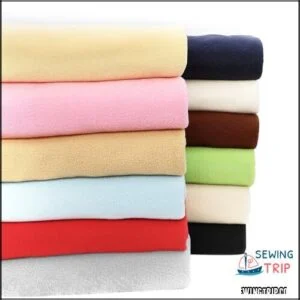
Perfect for crafting cuddly creations, knitted polar fleece fabric squares are a dream come true for stuffed animal enthusiasts.
They’re soft, lightweight, and warm, making them the ultimate "hug in fabric form". The anti-pill treatment guarantees your projects stay smooth and cozy even after countless snuggles.
These squares are easy to cut, don’t fray, and hold their shape well, which is great for beginners and pros alike. Plus, their vibrant colors and durability make your plushies look stunning and lasting!
One key benefit is that they’re more durable than softer plush fleece, which is a significant advantage for creating long-lasting and cuddly creations.
Best For: Craft enthusiasts and DIYers looking to create durable and vibrant plush toys, blankets, and other cuddly projects.
- Durable, anti-pill, and holds shape well for long-lasting creations.
- Vibrant colors and lightweight fabric ideal for crafting.
- Soft, warm, and easy-to-cut material, perfect for beginners and pros.
- Mixed reviews on thickness and overall quality.
- Some customers find the price high for the quantity provided.
- Requires careful handling to maintain its premium quality.
3. Sew Adorable Pet Pillows to Make
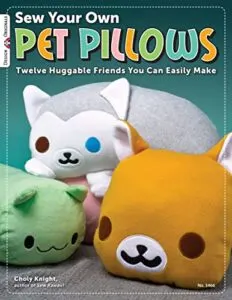 View On Amazon
View On Amazon If you’ve ever wanted to blend creativity with comfort, making pet pillows is your ticket.
These cozy, animal-themed pillows add charm and personality to a room, doubling as adorable companions and playful décor.
The designs, featuring foxes to corgis, use soft fabrics like fleece for ultimate snuggles.
Don’t worry if you’re new to sewing—each project is beginner-friendly with straightforward patterns and affordable materials.
Imagine giving personalized gifts or crafting cozy headrests for travel.
They’re fun, functional, and full of heart!
Best For: Creativity enthusiasts, sewing beginners, and anyone looking to craft cozy, personalized gifts.
- Beginner-friendly with simple patterns and instructions.
- Affordable materials make it accessible for all budgets.
- Doubles as a cute décor piece and functional pillow.
- Requires access to a sewing machine and basic tools.
- Suitable fabric options may not always be readily available.
- Some designs may need practice for perfect results.
4. Animal Theme Cotton Fabric Quarters

In the context of making adorable stuffed animals, animal theme cotton fabric quarters are a game changer.
These 100% cotton fat quarters are pre-cut, making crafting less of a hassle.
With prints featuring whimsical woodland creatures and playful jungle animals, they’re fun for kids and charming for adult projects.
Plus, their silky smooth texture is a delight to work with.
Just pre-wash to prevent shrinkage, and you’re good to go.
Whether you’re quilting or crafting, these bring personality to every creation!
Best For: Crafters and sewing enthusiasts looking to create quilts, baby items, and charming stuffed animals with ease.
- Pre-cut and ready for crafting, saving time and effort.
- Features cute, versatile animal prints suitable for all ages.
- High-quality cotton with smooth texture and vibrant designs.
- Slight shrinkage may occur if not pre-washed.
- Some users found the fabric thin for clothing projects.
- Occasional minor size discrepancies reported with precuts.
5. White Minky Fabric Soft Plush
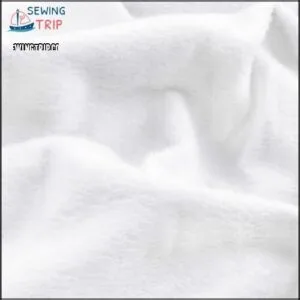
When you need fabric that feels like a cozy hug, White Minky Soft Plush delivers.
Made from 100% polyester, it’s unbelievably soft, lightweight, and perfect for crafting stuffed animals.
Its velvety texture adds a touch of luxury, while the 60-inch width gives plenty of room for big projects.
Plus, it’s machine-washable and durable, so you don’t have to worry about wear and tear.
Whether you’re sewing a cuddly bear or a plush blanket, this fabric’s versatility and charm make it a standout choice!
Best For: Crafters and DIY enthusiasts looking for soft, durable, and versatile fabric for plush toys, blankets, and creative sewing projects.
- Ultra-soft and velvety texture adds luxury to projects.
- Wide 60-inch fabric provides plenty of material for large projects.
- Machine-washable and durable, ensuring long-lasting quality.
- Some users find the fabric too thin for specific purposes.
- Mixed reviews about color accuracy and fabric type discrepancies.
- Limited thickness may not meet all crafting needs.
6. Assorted Color Soft Felt Fabric
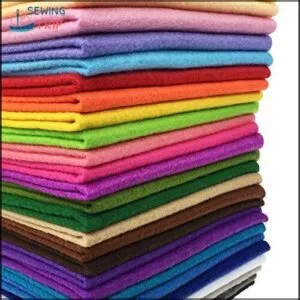
Whether you’re making a cuddly plushie or crafting a one-of-a-kind stuffed animal, soft felt fabric is your best buddy for versatility.
With 28 vibrant colors, it’s like having a rainbow at your fingertips! Being non-woven and easy to cut, sew, and glue, it’s perfect for beginners and experts alike.
Plus, it stays fuss-free—no unraveling here! While it’s not the stretchiest option, its durability makes up for it.
For bold colors and simple handling, felt’s truly hard to beat.
Best For: Beginners and craft enthusiasts looking for colorful, easy-to-use felt for DIY projects and decorations.
- Vibrant assorted colors, perfect for adding variety to projects.
- Non-woven fabric, easy to cut, sew, and glue without fraying.
- Soft and pliable texture suitable for various crafts and sewing projects.
- Limited stretch, making it less ideal for creating rounded or plush shapes.
- Thin material may not hold up well for heavy-duty or beading projects.
- Packaging is not discreet, which may be a drawback for gifting.
7. White Teddy Bear Plush Fabric
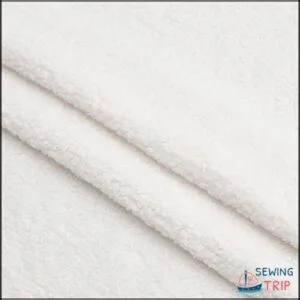
White teddy bear plush fabric is a dream for crafting soft toys—it’s like a hug in material form.
Made from high-quality polyester fiber, it’s soft, fluffy, and easy to sew. Its 1mm thickness is ideal for shaping plushies or creating cozy autumn clothing.
Don’t worry about color fading—it’s bright and durable, perfect for handmade projects. Just remember to hand wash gently or use a delicate machine cycle to preserve its quality and ensure it remains a soft and fluffy delight.
Whether you’re a beginner or expert, this fabric brings warmth and charm to your creations.
Best For: Craft enthusiasts, beginner or experienced, looking to create plush toys, cozy clothing, or warm accessories.
- Soft, fluffy, and easy to sew.
- Durable bright color that resists fading.
- Versatile for toys, clothing, and DIY projects.
- Requires hand washing or delicate machine cycle for maintenance.
- Limited pile height options for varied textures.
- Slightly pricey for some crafting budgets.
8. Woodland Animal Print Cotton Fabric
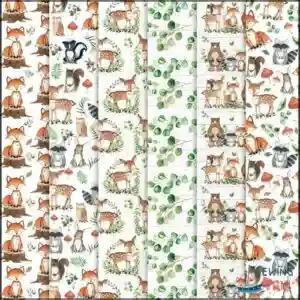
Woodland Animal Print Cotton Fabric is perfect for playful, cozy sewing projects.
With adorable animal motifs and eucalyptus designs, it adds charm to stuffed animals or baby quilts. Its soft cotton material is easy to cut and sew, making crafting effortless.
While it’s durable and long-lasting, some edges may need trimming, and the fabric can feel slightly stiff.
It’s an eye-catcher for personalized DIY creations like dolls or gift wraps, though not ideal for soft clothing, and is overall delightful, whimsical, and versatile.
Best For: Sewing enthusiasts and DIY crafters looking for charming, woodland-themed cotton fabric for creative projects.
- Adorable woodland animal and eucalyptus designs that stand out.
- Soft, durable cotton material that’s easy to cut and sew.
- Versatile usage for baby quilts, dolls, gift wrapping, and home décor.
- Edges may require trimming due to uneven cuts.
- Fabric may feel stiff, limiting suitability for clothing.
- Pattern alignment issues can lead to fabric waste.
9. Kids Sewing Kit Beginner Crafts

Kids sewing kit beginner crafts are a game-changer for introducing little hands to sewing while keeping things fun and frustration-free.
Pre-cut shapes, vibrant fabrics, and safe plastic tools make these kits perfect for beginners.
With projects like plush toys, keychains, and mini pillows, kids build confidence and creativity with each stitch.
The pre-punched holes remove guesswork, leaving no room for "oops" moments.
It’s more than fabric—it’s a gateway to pride and accomplishment, with laughter and bonding sewn into every creation.
Best For: Kids aged 5+ who are beginning to learn sewing and enjoy creative hands-on projects.
- Pre-cut shapes and pre-punched holes simplify crafting for beginners.
- Promotes creativity and confidence with easy, fun projects.
- Safe materials and plastic tools ensure worry-free use for kids.
- Limited to seven small projects, which may not keep advanced users engaged long-term.
- Requires adult supervision for younger children despite being beginner-friendly.
- Does not include glue for non-sewing activities, limiting flexibility.
10. Safari Animals Cotton Fabric Bundle
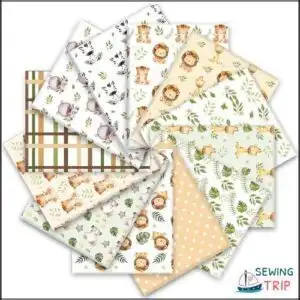
A safari theme instantly adds charm, and the Safari Animals Cotton Fabric Bundle is no exception.
These watercolor-style prints of lions, giraffes, and elephants bring your plush projects to life.
Made of premium cotton, it’s soft, odorless, and easy to cut, though fraying might need extra attention.
Each piece is 18 x 22 inches—perfect for DIY crafts like dolls or patchwork.
While some users praise its quality, others mention thin material as a drawback.
For whimsical, handmade creations, it’s a delightful choice!
Best For: Crafting enthusiasts who love creating safari-themed DIY projects, quilting, or sewing unique handmade gifts.
- Soft, odorless premium cotton fabric in charming safari-themed designs.
- Easy to cut and customize for various sewing projects.
- Versatile for patchwork, quilting, dolls, and other crafts.
- Tendency to fray, requiring careful handling while crafting.
- Thin material may not meet expectations for heavier projects.
- Mixed durability reviews, with some users noting issues after washing.
Fabric Quality Factors
When you’re choosing fabric for stuffed animals, quality isn’t just a nice-to-have—it’s everything.
From safety to durability, soft cuddles to easy cleaning, picking the right material makes all the difference.
Safety
Safety is a must when choosing fabric for stuffed animals.
Prioritize materials that meet toy safety standards and are free from allergens.
- Non-toxic materials guarantee no harmful chemicals.
- Hypoallergenic fabrics reduce fabric allergies.
- Seam strength prevents choking hazards from loose fillings.
- Flammability standards guard against fire risks.
Think safe, cuddle-worthy fabrics for happy moments!
Durability
How do you make a plush fabric endure years of hugs? Focus on durability!
Look for washable fabric with strong seam strength and tear resistance—stuffed animals endure plenty of playtime adventures.
Avoid pilling; it keeps your creations looking fresh.
Durable fabric guarantees long-term wear and easy cleanup, making it perfect for cherished toys, and helps you Build loveable memories, not repairs!
Comfort & Softness
Comfort and softness are key when sewing soft toys.
The fabric feel should invite cuddles, and plush pile adds to that warm, sensory experience. Opt for baby-safe fabrics like minky or velvet for snuggly results. Fabric weight considerations also play a role in the final product.
- Tactile qualities: Choose gentle textures for a soothing touch.
- Fabric textures: Prioritize smooth, plush fabric options.
- Sensory experience: Pair softness with safety for ultimate comfort.
Cleaning & Maintenance
Cleaning plushies doesn’t have to feel like a science experiment. For fabric care, spot cleaning works wonders for quick stain removal.
Skip harsh detergents—mild soap and a damp cloth are your best friends. Need to wash? Stick to gentle washing methods and air drying techniques.
Store stuffed animals in breathable bags to avoid moisture, and always handle repairs patiently!
Color Fastness
When choosing fabric for sewing stuffed animals, check its color fastness.
Plush fabric with stable dye minimizes bleed potential during washing.
Strong wash resistance and rubbing fastness mean fewer faded toys.
Light exposure can dull colors, so opt for durable options.
Prioritize fabric care for vibrant, long-lasting results in your plush toy making—trust me, it’s worth it!
Selecting Best Fabric
Choosing the right fabric for stuffed animals isn’t just about looks—it’s about getting that perfect balance of softness, durability, and ease of sewing.
You’ll thank yourself later when your creation holds up to countless hugs and cuddles, ensuring durability in the face of affection.
Importance of High-Quality Fabrics
When crafting stuffed animals, high-quality fabric isn’t just a luxury—it’s a necessity.
It guarantees:
- Child safety: No harmful materials or loose fibers.
- Fabric longevity: Toys survive endless hugs and adventures.
- Plushie appearance: Vibrant, soft fabrics delight every time.
- Cost implications: Quality saves money in the long run.
The right plush fabric enhances durability and creates lasting sensory joy.
Factors to Consider When Choosing Fabric
When picking fabric for stuffed animals, think safety first—no sharp textures or risks.
Durability needs matter too, especially for favorite toys. Plush fabric like minky or faux fur adds softness, while cotton fabric works for sturdy details.
Choose colors that pop, but don’t break the bank. Bonus? Easy cleaning turns laundry day into less of a struggle with easy cleaning!
Commonly Used Fabrics for Plushies
In the context of plushies, you’ve got options! Cotton fabric is practical, felt fabric adds durability, and plush fabric like faux fur brings unmatched softness.
Safety matters—fabrics should suit washing impacts and don’t risk harm. Texture variety keeps your creations unique, while cost analysis helps budget wisely.
Think about durability needs for long-lasting stuffed animals.
Specific Types of Fabric for Plushies
When diving into plush fabric choices, keep these specific types in mind:
- Minky Alternatives: Soft and stretchy, but easy to clean.
- Faux Fur Pros: Luxurious feel, though trickier to sew.
- Recycled Options: Eco-friendly and durable, offering guilt-free crafting.
Organic cotton and blended fabrics bring versatility, while felt fabric and fleece are timeless staples.
Find what suits your project’s vibe!
CustomPlushMaker Services
If you dream of creating unique stuffed animals, CustomPlushMaker’s got you covered.
They offer design customization, fabric sourcing, and prototyping options to bring your ideas to life.
Whether you’re sewing DIY stuffed animals or need toy making supplies, their services scale to fit your needs—from small crafting fabric orders to large batches.
It’s your one-stop shop for seamless order fulfillment, offering a range of services that make it easy to bring your ideas to life with customization options.
Frequently Asked Questions (FAQs)
What fabric is best for making stuffed animals?
The best fabric for stuffed animals depends on your vibe.
Fleece is soft and cuddly, felt’s great for details, and minky adds luxe coziness.
Pick fabrics that feel good and match your design’s personality.
What is stuffed animal fabric called?
Think of a stuffed animal as wearing a soft, snuggly "coat."
This fabric is usually fleece, minky, or felt.
These materials are cozy, stretchy, and perfect for creating lovable, huggable toys you’ll adore!
How many yards of fabric do I need for a stuffed animal?
You’ll usually need about half a yard of fabric for a small stuffed animal, but bigger designs or multiple pieces might require 1-2 yards.
Always check your pattern and grab extra—just in case!
What material is used for making soft toys?
Making soft toys feels like crafting hugs—plush fabrics like fleece, faux fur, and minky add softness, while cotton, felt, and quilting fabrics provide durability.
Each material shapes the toy’s personality, making it cozy and lovable.
How to prevent fabric pilling on plush toys?
To stop fabric pilling on plush toys, choose tighter-woven fabrics, avoid rough handling, and wash with care.
Turn the toy inside out, use cold water, and a gentle cycle.
It’s like babysitting your fabric—be gentle!
What tools improve precision when cutting plush fabric?
Cutting corners" isn’t an option here—use sharp fabric scissors or a rotary cutter with a cutting mat for precision.
Add pattern weights to keep fabric steady, and remember: gentle hands make smoother cuts!
Are hypoallergenic fabrics available for stuffed animals?
Yes, hypoallergenic fabrics like organic cotton, bamboo fabric, and certain polyester blends are available for stuffed animals.
They’re super soft, safe for sensitive skin, and perfect for creating cuddly, allergy-friendly companions, with hypoallergenic fabrics being the key to their comfort.
How to troubleshoot sewing challenges with stretchy fabrics?
You’d think stretchy fabric would play nice, but no—it slides, puckers, and mocks you.
Use ballpoint needles, adjust tension, and add stabilizers like tissue paper.
Take it slow, and don’t skip pinning!
Can fabric blends affect durability of plush toys?
Fabric blends can absolutely impact plush toy durability.
Some mixes, like polyester-cotton, balance softness and strength, while others might fray or stretch too easily.
Test your blend—it’s no fun repairing a toy mid-hug!
Conclusion
Choosing the right fabric for sewing stuffed animals is like finding the perfect puzzle piece—it just fits and brings everything together!
From cozy fleece to luxurious minky, each fabric offers unique qualities to match your vision.
Prioritize softness, durability, and how well it handles daily hugs (and occasional spills).
Don’t shy away from experimenting—your creativity can truly shine.
With the right fabric in hand, you’re not just sewing—you’re crafting something magical and snuggle-worthy!


